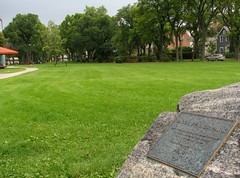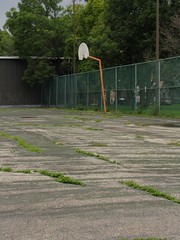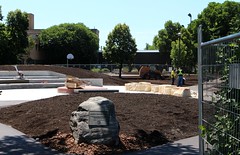©2022, Christian Cassidy
The Winnipeg Architecture Foundation (WAF) and Daniel
McIntyre/St. Matthews Community Association (DMSMCA) teamed up to create
a kids' walking tour map of the park and area around it. Hard copies
can be picked up at the DMSMCA Resource Centre on Ellice Avenue or it can be downloaded at the WAF's website.
Jacob
Penner Park, formerly Notre Dame Park, at Notre Dame Avenue and Victor Street is not one of city's best-known
green spaces. More than a century ago, it was "ground zero" for the city's tree and flower planting programs by the city's first parks board.
Here's a look back at its history.
The
City of Winnipeg was established on January 1, 1874, and due to the
massive population growth in its first couple of decades had trouble
keeping up with basic infrastructure such as constructing roads and
providing fire protection. "Soft ” municipal services like libraries and parks had
to wait in line.
In 1892, a petition with 300 names was
presented to city council that demanded the formation of a parks board that
would create green spaces and gardens in the rapidly urbanizing city.
Grudgingly, city council included the question in a public referendum at that year's civic election and it passed 1,129 to 185.
Thanks to
Alderman George Carruthers who pushed council to act on the referendum and and
even wrote the city's parks bylaw for them to vote on, the new parks
board was established in February 1893.
The first chairman of the new parks board was brewer Edward Drewry.
Edward and his brother Fred were strong advocates of "fresh air spaces"
and recreational activities that could be accessed by all citizens.
Edward
envisioned numerous smaller public green spaces dotting the city,
including near working-class neighbourhoods. For his part, Fred
established a system of cycling paths in the 1890s that only in recent years has Winnipeg tried to emulate.
In
1893 – 94, Drewry and his parks board purchased eight pieces of land
that would be converted into parks. One of them was this four-acre
site on Notre Dame Avenue between Victor and McGee Streets that cost
$4,500. The other sites were what eventually became Fort Rouge Park, Central Park, Victoria
Park, St. John's Park, Selkirk Park, Dufferin Park, and St. James Park.
The
Notre Dame site was still available for purchase because it was
low-lying, swampy and hard to sell to property developers.
(Central Park and Fort Rouge Park on River Avenue came about for the
same reason.)
Also in 1894, the parks board hired its first parks superintendent, David D. England.
Not
a lot is known about England's background except that he was originally
from Scotland and a gardener by trade. In fact, he publicly corrected
politicians and reporters who referred to him as 'parks superintendent'
preferring instead the title 'city gardener'.
England set up shop
in the south-east corner of the park, which was the least swampy
section, and established a greenhouse and experimental garden as he was
responsible for growing all of the plants
that filled the city's parks and other high profile spaces like city hall square.
Though
he foresaw a day when the city's green spaces would be filled with
indigenous species of plants, flowers, and grasses, most of his work was
dedicated to determining what European species could be grown here.

April 14, 1905, Winnipeg Free Press
England's legacy can still be seen on many streets in the city's core.
The pressure was on in the late 1890s to choose a standard tree to install on the boulevards of the rapidly developing city. England was sent to
several cities in the eastern United States and Canada to do his
research and by 1900 chose the American Elm for its relatively quick
rate of growth and its full canopy.
The city then began issuing
tenders for hundreds, then thousands, of elm saplings annually to be
delivered to Notre Dame Park from where they would be dispatched and
planted around the city by England's crews.
According to England, when
he started with the city there were five miles of trees along its
streets and by the end of 1906 there were 20,000 trees along fifty
miles of street.
City
surveyors were sent in to formally lay out streets, boulevards, water
mains and sewers in the area around the park around 1900 and residential
development of those lots began around 1904. That was the same year
that the park underwent some major improvements.
The swampier parts
were drained and 2,000 cartloads of earth were brought to fill them in.
This allowed for the addition of public paths, experimental gardens open to the public, and an expansion fo the greenhouse.
Addressing the Parks
Board in March 1905, England said, “...there
are thousands of plants and perennials being tested, which make the
park very interesting and instructive and hundreds of people go there
for no other purpose than to see the trials and the varieties.”
One of the most contentious issues was that there was no employee classification for "gardener" at the city. England constantly chided the board that Winnipeg was one of the only cities in Canada not to recognize the profession and as a result, he had to rely on "general labourers" to make up his crews, some of whom were less than satisfactory workers.
England may have excelled as a gardener but he was a poor manager. As time went by, the parks board raised issues about employee performance and questionable spending under his tenure.
At one point, employees leaked to the board that England was doing private consulting on city time. His defence was that he believed part of his duties as city gardener was to provide advice to landowners and groups like the Horticultural Society. He said he didn't take any money for this extra work.
The final straw came in 1906 when a couple of fired employees accused him of making improvements to his personal property using city plants and staff. He denied the charges.
Despite the anger of most board members, as a favour for his years of service he was given an opportunity to resign moments before they voted to dismiss him in December 1906. This allowed him to collect a two-month severance package.
England soon found himself in Victoria for a brief stint as their parks superintendent before moving on to Los Angeles where he did landscaping for private estates. He died in L.A. on June 18, 1929. (For more about England's time in Winnipeg and beyond.)
The greenhouses were moved from Notre Dame Park to Assiniboine Park in the mid-1920s. That corner of the park, though, was still used by the city as a works yard and a vehicle garage was added in 1929.
Notre Dame Park nearly disappeared in 1930 after it was chosen as the runner-up site for the city's proposed Public Baths No. 2. The facility would replace the recently closed Cornish Baths and was slated for Sherbrook Street but one of the property owners refused to sell his lot to the city for a reasonable price.
As the city already owned Notre Dame Park, there was no worry about land ownership and construction on the now-delayed project could get started right away.
Some groups, including the Board of Trade, urged the city to go back to the Sherbrook Street property owner and make a final "take it or leave it" offer. They did, and a price was negotiated that both could live with.
Notre Dame Park survived.
With the Sherbrook Pool's construction underway, the city focused on making further improvements to Notre Dame Park. The small playground was expanded and a wading pool was added. One newspaper report said that a thousand children came out for the pool's grand opening on July 2, 1931.
In the 1930s the warehouse became headquarters for the city's mosquito fighting campaign. At the time, mosquito control consisted of a fleet of trucks pouring oil into standing ponds and ditches around the city to kill larvae.
Due to its wading pool and playground, the park became a hub for area children. An August 1962 Winnipeg Tribune story quoted a park supervisor as saying about 300 children came each day.
In the decades since, the park has had numerous upgrades but the footprint has remained essentially the same. The south-east corner is still a city works yard for the parks department and it still has a wading pool and playground.
Notre Dame Park was renamed in honour of Jacob Penner in 2000.
Jacob and Rose Penner came to Canada in 1904 from their native Russia and settled in Winnipeg where they became increasingly concerned with the plight of the city’s poor and working class. Jacob, an accountant by trade, felt that political activism was the best way to achieve improvements. He was a labour organizer during the Winnipeg General Strike and a founder of the Socialist and Communist parties of Canada.
In 1934, Penner was elected to Winnipeg city council representing Ward 3 (the North End) as a Communist. Even though the position of alderman was part-time, he gave up his job to serve full-time on his $25 per month city salary. He fought for quality, affordable housing, and better treatment of working men and families.
Penner served until 1940 when he was arrested under Ottawa’s wartime Defense of Canada Regulations for being a “known and dangerous communist” and was interred in a Quebec concentration camp for 22 months.
Upon his release, Penner was re-elected to his old seat and remained on council until he retired in 1961. Another Communist, Joe Zuken, was elected to the seat in the October 1961 election.
Jacob Penner died on August 28, 1965.
On August 25, 2000, with son Roland Penner in attendance, the park was renamed in a small ceremony. The plaque inside the park reads:"Jacob Penner, city alderman 1934 - 1962. He dedicated himself to the people of the city he loved so well."
In recent years, the park had become run down and it was announced in 20221 that it would receive a $225,000 makeover from the Building Communities Initiative.
The city worked with community groups like the Daniel McIntyre St. Matthews Community Association and Spence Neighbourhood Association to find out what residents wanted to see in the revamped park.
Renovations took place in the summer of 2013.
The sod was replaced and new paths and furniture were added. The old tennis court area was turned into a community garden and a basketball half-court. The largest feature to be added was a skateboard park.


























No comments:
Post a Comment